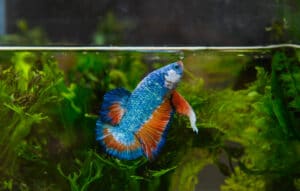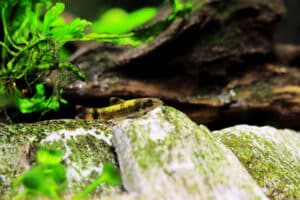So you walk by your aquarium and look at all your fish swimming around and doing their thing. But, you notice something awful! The lower feeler things on your Angelfish are missing!
Your next question probably is, “Do Angelfish feelers grow back?” Take a deep breath. Yes, they do. However, this will largely rely on how bad the damage is and if it’s partially intact. If so, then they should grow back in six to eight weeks. Therefore, you can rest easy knowing it’s at least possible.
But, you have to be proactive about helping your Angelfish heal. This means setting up a quarantine tank, figuring out how the fin came off in the first place, and removing the potential for it to happen again.
Understanding “Feelers”

Before continuing, understand the “feelers” on your Angelfish have a name. Called “ventral fins” or “pelvis fins,” Angelfish have 2 feelers in front of the anal fin.
The ventral fin and the anal fin are located in the bottom part of the fish and they help with steering and balance. So it becomes important to not let our fish to live without such crucial body parts.
So, in the case you notice they’re missing, observe the fish and how it swims along with the way the ventral fins look. Then answer the following questions:
- Are both ventral fins gone?
- Is the damaged fin totally removed, or is it partially intact?
- Do the fin(s) look nipped at, chewed on, or ripped off?
- Does the Angelfish have trouble swimming?
- Is the Angelfish acting unusually aggressive?
- Is the main tank’s temperature colder than what Angelfish prefer?
- Are there any signs of fin rot? (more about this below)
Deciding the Next Steps
Once you finish attempting to answer these questions, you’ll have a better idea of where to go from here.
The answers will tell you how likely it is for the fins to grow back and how to prevent the problem from repeating. It will also help you decide the level of urgency in setting up a quarantine tank.
What’s more, the appearance of the ventral fins will tell you a lot about how they came off. If they look ripped or torn, something in the tank is far too rough for your Angelfish. This could be from things like plants, décor, the substrate, or fin rot.
Gouges, Bites; Length
When you see gouges or strategic-looking bites at the point of injury, other fish may have nipped/bit it off.
When the ventral fins appear completely torn off at the base, there are a few possible causes.
The Angelfish could have gotten into a serious standoff with another fish, or perhaps it got too close to the equipment. Alternatively, it could be due to the main tank being far too small for the Angelfish.
Cold Water Temperatures
Another cause for pelvic fin loss could be from the water temperature being too cold for the Angelfish.
It’s not infrequent for this dreamy-looking aquatic creature to drop their ventral fins or have them look raggy in response to their immediate environment.
Enemies, Fin Rot; Quarantine Tanks
Next, decide whether you have to remove the Angelfish from the main tank or not and put them in a quarantine tank.
If there are signs of fin rot or if you know the Angelfish has enemies, you must set one up as soon as possible.
Even if there aren’t enemies, quarantine will help the fish’s recovery and prevent further damage. The Angelfish won’t have to fight for food or have to avert trouble.
Related Read: Why Do Angelfish Keep Dying?
Understanding Fin Rot
Fin rot is a serious condition, and this propensity increases when their fins are missing or damaged.
When the pelvic fin looks dark red and rotted along with jaggedness or unevenness in some way, it’s a sure sign of fin rot.
Oftentimes there will be a white growth, which means the infection has set in.
What’s more, this can be bacterial or fungal in nature. You’ll know it’s bacterial when it looks really dark and super rough. White growths indicate that it’s a fungal infection.
Check Out: Fin Rot Recovery Signs And Treatment Guide
A Note about Deformities
Some people wonder whether they can cut off a bent or other kind of deformity to the ventral fin. This isn’t a good idea.
Not only do you risk the pelvic fin from not growing back, but it will also be an exercise in futility. The deformity will just grow back in the same way.
Setting Up a Quarantine Tank
For the quarantine tank, make sure your Angelfish has the appropriate water parameters. Certainly, you already know, but ensure the tank’s water is at a pH level between 6.8 and 7.8 with a temperature ranging from 76°F to 84°F.
The water hardness should also be 3° to 8° dKH (or 54 to 145 ppm).
You may even want to turn the temperature up closer to 84°F. Bacteria and fungus can’t grow in such warm conditions, and it will help promote the reparative growth of the fin.
Adding Aquarium Salt
In the event, your Angelfish is exerting signs of fin rot or you have concerns about it developing, you can add a pinch of aquarium salt.
Of course, you want to be careful and read the manufacturer’s instructions. But, generally, a ½ teaspoon per gallon should do the trick. It will simultaneously prevent and treat the fin rot.
Read: Can You Add Table Salt To A Fish Tank?
Continued Care
Once the parameters are perfect for the Angelfish, put it in the tank with proper acclimation procedures. Maintain water conditions with meticulous care and do partial water changes as needed. Every so often, inspect the pelvic fin area to ensure there is growth and to check continually for fin rot.
Inspect the Main Tank
Once you have your Angelfish safe and secure, inspect the main tank. First, check the water parameters, temperature, pH balance, and water hardness. Fix whatever you have to so it can be inhabitable for the Angelfish when it returns.
Sharp Objects; Free Space
Then look at the overall layout and design. Check substrate and décor for sharp edges. Inspect live plants for any dead, hardened growth.
Also, make sure the size of the tank and everything in it doesn’t crowd the Angelfish’s ability to swim around freely.
Remove whatever you think is too sharp, rough, or harsh on the Angelfish’s fins. This includes removing décor and plants that might make the space too cramped.
Observe Tank Mates
Finally, determine if any culprits bit or nipped off the ventral fins. When in doubt, do a thorough background study of everything living with your Angelfish, including the plants.
Make sure there’s nothing that could be damaging it. You may have to do a bit of surveillance and see if there are any fish acting aggressively or being a bully in some way.
Read Also:
Final Thoughts
Whenever you notice something wrong with the “feelers,” or ventral fins, of your Angelfish, it’s important you take care of this problem quickly. It will grow back, but you have to be proactive about helping things along. Identify the cause of the loss and act accordingly.
Hi! I’m Praveen Ghoshal, the founder of eFishkeeping.com. Inspired by my Dad, I got interested in fishkeeping when I was a kid. Since then, I have been involved with this hobby. Currently, I have 3 fish tanks at our home, and I enjoy this hobby with my full family. Read more about me here.







![Do Neon Tetras Die Easily? [Here’s The Truth!] do-neon-tetras-die-easily](https://efishkeeping.com/wp-content/uploads/2023/03/do-neon-tetras-die-easily-300x200.jpg)